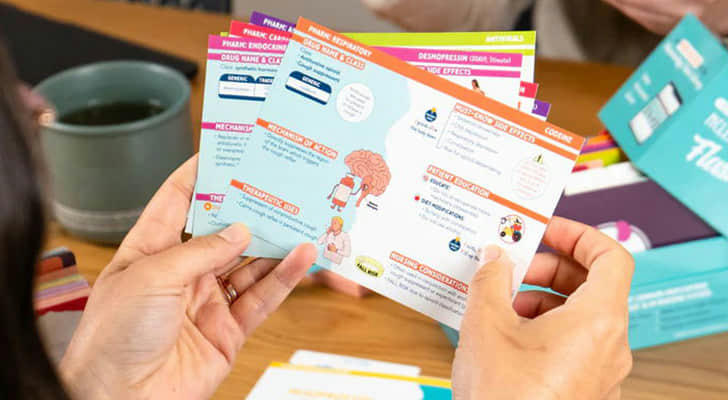These Methods Will Help You Master and Retain Pharmacology Effectively

Pharmacology involves understanding how medications affect the body and how the body processes these drugs. This subject is crucial for students in medicine, nursing, and pharmacy, though it is often challenging due to the extensive number of drugs that need to be learned. Fortunately, there are several proven strategies to help students excel in pharmacology. Staying organized, adopting a systematic approach, and engaging with peers are key to mastering this complex subject and succeeding in your exams.
Essential Tips to Keep in Mind

Review Lecture Notes Regularly: Enhance your grasp of pharmacology by revisiting your notes after each class, gradually building your knowledge base. Focus on one topic at a time to avoid feeling overwhelmed.
Utilize Flashcards: Create flashcards for drug names, classifications, dosages, interactions, and side effects to boost your ability to recall crucial details.
Group Study: Collaborate with classmates to reduce preparation time and gain different perspectives. Teaching concepts to others can reinforce your understanding and fill in any gaps in your knowledge.
Approach 1: Effective Study Techniques for Pharmacology

Step 1: Review Material Post-Lecture
Reviewing your notes after each class is crucial. Instead of cramming the night before an exam, regularly engage with the material right after each lecture. This gradual study approach helps you steadily build your understanding and reduces the stress before exams.
A useful guideline is to dedicate one hour of study time for every hour spent in class. While this might seem demanding, maintaining this habit will prevent last-minute cramming and make exam preparation more manageable.
Step 2: Focus on One Subject at a Time
Concentrate on one subject during each study session. Attempting to cover multiple topics simultaneously can lead to confusion and inefficiency. For instance, if you study three different drug classes in one sitting, you may mix up the details. Instead, divide your study material into distinct, manageable topics and focus solely on one at a time.
Set a clear goal, such as, “In the next hour, I will review Beta blockers,” and stick to it. Avoid distractions to enhance the effectiveness of your study session.
Remember to take short breaks between sessions. A brief rest can rejuvenate you and improve your focus for the next round of studying.
Step 3: Create and Use Flashcards
Flashcards are a highly effective tool for memorizing drug information. Write the name of each drug on one side of an index card, and list key details such as drug type, dosage, interactions, and side effects on the other side. Regularly test yourself with these cards to reinforce your memory.
Alternatively, pre-made flashcards are available for purchase from study aids vendors. You can find them online or at your university bookstore.
Carry these flashcards with you to utilize idle moments for study, such as during your commute.
Step 4: Develop Visual Aids
Designing visual aids like graphs or flowcharts can significantly enhance your learning process. Creating these visuals not only provides you with effective study tools but also reinforces your knowledge during their creation.
For example, construct a flowchart starting with a broad drug category at the top, branching down into specific drug types, and ending with individual drugs. This visual organization allows for quick reference and easier comprehension.
If you prefer not to create your own visuals, you can find useful graphics on platforms like Pinterest, where other students share their study aids. Always verify the accuracy of any online materials you use.
Step 5: Employ Mnemonic Devices
Mnemonic devices are memory aids that use phrases or associations to help recall information. These techniques are commonly used by medical students to memorize drugs, anatomical terms, and other complex subjects. Develop your own mnemonics to remember drug classifications—creativity is key, and the mnemonics only need to be meaningful to you.
For instance, you might remember that Prazosin is an Alpha blocker by linking its name ending in “sin” with the concept of "sin" being opposite to "Alpha" (symbolized as "God").
If you prefer, search online or consult classmates for existing mnemonic devices that might help.
Approach 2: Enhancing Pharmacology Learning Through Collaboration

Step 1: Join a Study Group
Participate in a study group. Collaborating with classmates can be highly beneficial as you all share the same goal. Forming a study group allows members to create and exchange study materials like graphs, flashcards, and guides, reducing individual workload and providing mutual support.
Regularly meet with your group to test each other’s knowledge. Reviewing past exams together and discussing incorrect answers can also be an effective way to reinforce your understanding.
Step 2: Explain Concepts to Others
Explain concepts to others. One of the most effective ways to gauge your comprehension is by teaching the material. After studying a topic, try to explain it to friends, family members, or classmates. This will help you assess how well you grasp the material and your ability to convey it clearly.
While teaching within your study group is useful, presenting the material to someone outside of your pharmacology course can be even more revealing. If you can simplify and communicate the concepts to someone unfamiliar with the subject, it demonstrates a deeper level of understanding.
Step 3: Seek Guidance from Professors
Seek guidance from your professors. Your professors are subject matter experts and can offer valuable advice and study tips. Don’t hesitate to reach out to them for help—they have undergone similar educational journeys and likely have developed effective study techniques that could benefit you.
Approach 3: Categorizing Drugs for Effective Study

Step 1: Organize Drugs into Broad Categories
Organize drugs into broad categories. Begin your pharmacology study by focusing on large drug categories. Starting with a broad overview helps prevent being overwhelmed by the sheer number of drugs. Group drugs into major categories based on their similarities and effects before delving into specifics.
For instance, antibiotics can be categorized into several major groups. Rather than trying to memorize each antibiotic individually, start with a general classification such as “Antibiotics,” and then progressively learn more detailed information about each subgroup.
For additional large drug categories, check out resources like Drugs.com.
Step 2: Understand How Each Drug Class Affects the Body
Understand how each drug class affects the body. Each drug category is characterized by its specific effects on the body. Once you have classified the broad drug categories, focus on understanding how each class interacts with the body, the mechanisms involved, and the conditions it treats.
For example, antibiotics are designed to combat bacterial infections and are ineffective against viruses. This type of information is crucial to grasp the function of the antibiotic class.
Step 3: Delve into Drug Types Within Each Category
Examine drug types within each category. After mastering the general traits of each drug class, proceed to study the specific drug types within these categories. While these drugs share common characteristics, it’s important to differentiate between them based on their individual properties and uses.
For instance, within antibiotics, there are seven main types, each targeting different types of bacterial infections and having distinct side effects. Understanding these differences is key to mastering the details within each class.
Step 4: Prioritize Unique Side Effects
Focus on unique side effects. Rather than memorizing all possible side effects for each drug, concentrate on the more distinctive and less common ones. Most drugs may list common side effects such as nausea or diarrhea, so prioritize learning the specific and unique side effects associated with each drug class.
For example, if a drug class lists common side effects like nausea and diarrhea, but also includes insomnia, the latter is more critical to remember due to its uniqueness.
Step 5: Memorize Drug Suffixes
Memorize drug suffixes. Drug names often include suffixes that indicate their functional category. Learning the meanings of these suffixes can help you deduce the drug’s function even if you’re unfamiliar with the specific drug.
For instance, drugs with the suffix “-pril” are ACE inhibitors that affect the heart and kidneys, while those ending in “-olol” are Beta blockers impacting the heart, lungs, GI tract, and kidneys.
For a detailed list of drug suffixes, visit the US National Library of Medicine at Drug Name Generic Stems.
Step 6: Use a Spreadsheet for Organization
Utilize a spreadsheet for organization. Given the volume of information, a spreadsheet can be a valuable tool for keeping track of details. Create a spreadsheet that includes all pertinent information such as drug class, category, interactions, side effects, and dosages.
This spreadsheet will serve as a central resource for your studies, helping you efficiently review and organize your notes while creating flashcards and study guides.
